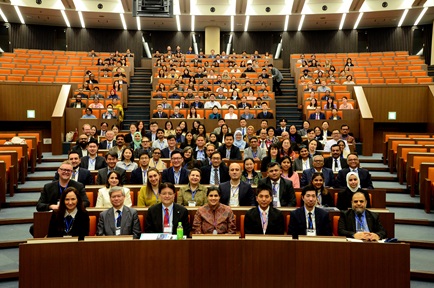Tech startup transformers: lessons from Grab on the journey towards legitimacy
Southeast Asia is a hotbed for exponential growth. Not surprisingly, the wave of burgeoning tech startups shows no sign of abating as a growing middle class and rapidly expanding internet access continue to boost a flourishing digital economy..
By Sia Siew Kien

Southeast Asia is a hotbed for exponential growth. Not surprisingly, the wave of burgeoning tech startups shows no sign of abating as a growing middle class and rapidly expanding internet access continue to boost a flourishing digital economy – increasingly influenced by a young, tech-savvy and entrepreneurial generation taking up the reins in the workforce. The region's e-commerce sales are projected to grow at a 32 percent CAGR from $5.5 billion in 2015 to $88 billion in 2025, according to research from Google and Temasek Holdings.
As more tech startups emerge from and venture into Southeast Asia's lucrative developing economies, what are the steps they must take to cut through the noise and succeed?
While continuous digital innovation is essential, aspiring startups – the fundamental premise of which is often disruption to the status quo – must realise the equally critical importance of devising strategies that allow them to gain legitimacy in the eyes of customers, industry bodies, and regulators. And with the huge diversity in cultural, societal and industry norms, lifestyles and urban geographies, as well as strenuous regulatory requirements across Southeast Asia, it is clear that new entrants cannot deploy a 'one size fits all' solution.
The Malaysian Government's recent legalisation of ride-hailing services this year – a nascent industry in Southeast Asia expected to be worth close to $13 billion by 2025 and catering to nearly 30 million monthly riders, according to Google – shows that there are valuable lessons to be learned from tech startup powerhouses like Grab that have revolutionised not just the taxi industry, but also the broader transportation and regulatory landscape in Malaysia and beyond.
Legitimacy starts with meeting local needs
Grab came to life for a simple reason: a mother's worry for her child's safety. By placing personal (and therefore highly localised) experience at the fore when devising many of the app's features, Grab's team of developers made Southeast Asia's biggest problems its key opportunities and parked itself firmly at the intersection of three growth pillars: safe and accessible transport, digital financial inclusion, and commerce enablement.
The Malaysian startup has seen tremendous growth as a result, and become a daily part of life for many people across the region. Today, Grab operates up to 2.5 million rides daily, making it the largest ride-hailing platform and preferred app for most drivers and passengers in Southeast Asia. Grab is in 55 cities across Southeast Asia, and the app has been downloaded onto over 45 million devices, triple the number from June 2016.
Going hyperlocal and augmenting growth
In addition to specific local needs and demands, close attention to industry partnerships and collaborations with the authorities has been key to Grab's success in Southeast Asia. In a world as diverse, politically complicated and fresh as Southeast Asia, Grab has evolved its approach to optimise an existing inventory and varying degrees of quality, supply and innovation, instead of altogether disrupting the landscape and system. Grab is focused on solutions that improve existing services and works with governments to introduce effective new ways of serving the public, and makes sure it has local teams in every country who know the local problems inside-out.
In 2016, it became the first ride-hailing company to partner with the World Bank to develop OpenTraffic, a non-profit global data platform currently available in Malaysia and the Philippines that shares real-time and historical traffic statistics. Meanwhile in collaboration with GovTech in Singapore, it is also using big data to identify popular routes that the working crowd take on their daily commute, before offering a specific one for its GrabShuttle service. It is a great example of transport optimisation: the service starts only when there are sufficient users who want to use it.
Constant movement towards continued relevance
Grab meanwhile has pursued a constant state of evolution to keep growing its Southeast Asia customer base and remain relevant. It is no longer just solving critical transportation issues, but reimagining payment methods that would give a more equal footing to the unbanked and the less connected – namely, those who do not have credit cards or bank accounts. It recently acquired Indonesian company Kudo, whose network of 400,000 agents can help bring Grab access to a significant population of Southeast Asia without bank accounts – a strategic move, given that the digital payments industry in this region alone is projected to grow into a $500 billion market by 2025.
Recently it announced GrabNow, a new service which digitises the street hailing experience, enabling passengers to flag down and connect instantly with a taxi driver via the Grab app – combining the immediacy of flagging with the benefits of the Grab platform, including best-in-class safety standards, upfront fixed fares and loyalty rewards.
Grab is also making the driving experience safer by expanding its telematics programme, and further enhancing its in-app messaging feature, GrabChat, designed for Southeast Asia's users who love and actively use messaging services. Just last month, it partnered with an online maps provider that rivals Google Maps to cater more specifically to the needs of commuters in this region, with features like places of interest and real-time traffic data, sourced by connected vehicles and devices.
Sustainable transformation
Grab's growth journey across the region is far from over; and while Uber currently reviews its Asia operations following allegations of misconduct including bribery, will Grab 'grab' the opportunity?
And what happens beyond the quest for legitimacy? Tech startups must now also contend with the question of sustainability. How long can their current business models last and can they ensure stable growth trajectories? Many successful tech startups have been willing to pay a very high price for customer acquisition to achieve scale, but this has also delayed their path to profitability.
The next challenge for the likes of Grab, and one that new entrants should plan for, is how it keeps its customers buckled in for the ride, keeping them loyal to its business to generate revenue over and over. That's a journey Apple is already on with its iOS platform. A lesson for another day.
About the author
Sia Siew Kien is associate professor of information systems at NTU's Nanyang Business School.
This commentary was published in Malay Mail Online on 24 October 2017.







